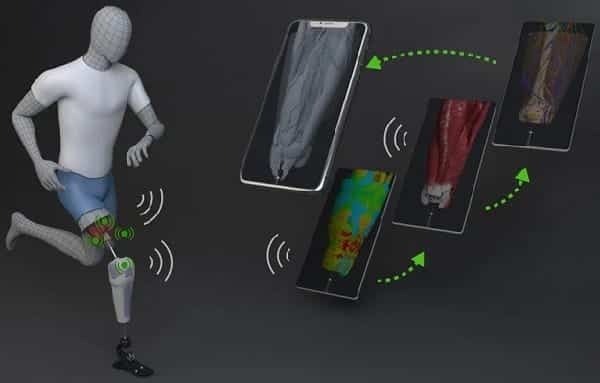As part of our mission to help those with limb differences learn about bionic limb technology, we periodically report on the latest research news. Below are the most interesting stories that we uncovered over the past two weeks.
An AI-Managed, Self-Adjusting Socket Liner
A few weeks ago, we reported on new technology for designing the perfect socket. This was from a company called Adapttech.
As most amputees know, the problem is that their residual limb changes throughout the day so that even a socket that fits perfectly in the morning may no longer fit properly by the afternoon.
But what if someone designed a socket liner that could automatically adjust to residual limb changes throughout the day? Introducing Roliner, which is short for “robotic liner”:
We spend a lot of time in amputee support forums, so we know how debilitating socket-fit problems can be. They’re also a problem for bionic limbs controlled by myoelectric sensors. This looks like another key element to solving these problems!
For more information, visit Unhindr’s website.
An Explosion in Prosthesis Design Tools
People often ask us why we’re so optimistic about the future of bionic limbs at BionicsForEveryone.com when the past has been a history of slow progress and frequent end-user dissatisfaction.
The answer is that everywhere we look around the world, we see brilliant scientists and engineers working hard to improve bionic technologies. No problem can withstand this kind of widespread, passionate, unrelenting assault.
We are especially confident because many scientists are developing sophisticated tools to improve the design process — a kind of loose parallel to the idea of machines designing ever-improving machines. Here is one example from Standford University:
Another example comes from Dr. Laurent Frossard, who previously provided us with incredible insight on bionic solutions involving osseointegration:
- Part 1: Advantages of Osseointegration
- Part 2: Disadvantages of Osseointegration
- Part 3: Eight Ways to Improve Osseointegration
- Part 4: Key Issues for Osseointegration Patients
One of the issues discussed in these interviews was that outcomes for osseointegration can vary significantly from tremendous success to catastrophic failure. But Dr. Frossard doesn’t just spend his time educating people. He’s also working to improve outcomes. He and Professor David Lloyd are collaborating to build an integrated, wearable, and non-invasive diagnostic device that will help them create a virtual replica (i.e. a digital twin) of a patient’s residuum.

This replica will not only help clinicians assess the movement of bone, muscle, tendon, fat, and skin in response to the use of a prosthesis in real-life conditions. It may also allow them to assess the likely effects of a proposed solution before implementing that solution!
For more information, please see The Future of Bionic Limbs.
Jaw-Dropping Advancements in 3D Printing
We write about bionic limbs, so it may surprise you to learn that, one day, we hope they’re no longer necessary.
Watch the following video from 6:54 to 13:30. The first 3 minutes are just background. The really interesting part starts at the 10:00:
Why is this so interesting? Because the speaker describes four example uses:
- a case where a young patient was able to avoid possible leg amputation despite losing half the patient’s pelvis;
- the use of an implant to replace a section of the femur crushed in an accident; this was not a case of avoiding immediate amputation, but, as many readers know, trying to salvage smashed bones and joints can often result in chronically painful situations that do eventually lead to amputation; this healthier, more integrated solution looks like it may offer permanent repair;
- the avoidance of amputation where a patient’s talus bone has died; this is particularly exciting because it suggests a possible pathway to salvaging mangled joints;
- controlled antibiotic release using 3D-printed bone implants; there is no direct mention of osseointegration here, but with bone infections posing one of the graver risks to osseointegrated implants, one wonders if these technologies might eventually merge;
The company behind these techniques is called Restor3d.
Why Do We Write About Such Cutting Edge Technologies?
We were asked the other day why we write about bionic or bionic-related technologies that are not yet available or may currently be quite difficult for the average person to access.
The answer is simple: patient awareness. If you’re having chronic socket problems, wouldn’t you want to know that a possible AI/robotic solution exists? Yes, you may have to track it down and persuade someone to let you try it, but that’s a lot better than having no hope of a solution.
If you sustained severe joint damage in the past, you’re tired of the chronic pain, and you are now contemplating amputation, wouldn’t you want to know that, if you just hang in there another year, you might be able to get the joint reconstructed through 3D printing and avoid amputation altogether?
Informed patients are empowered patients.
If you agree with our approach, please consider leaving a short testimonial here. We’re hoping to build a big enough wall of testimonials to persuade other organizations to work with us.
Related Information
Are you interested in bionic limb research? If so, see our complete selection of research articles.
For a comprehensive description of all current upper-limb technologies, devices, and research, see A Complete Guide to Bionic Arms & Hands.
For a comprehensive description of all current lower-limb technologies, devices, and research, see A Complete Guide to Bionic Legs & Feet.
